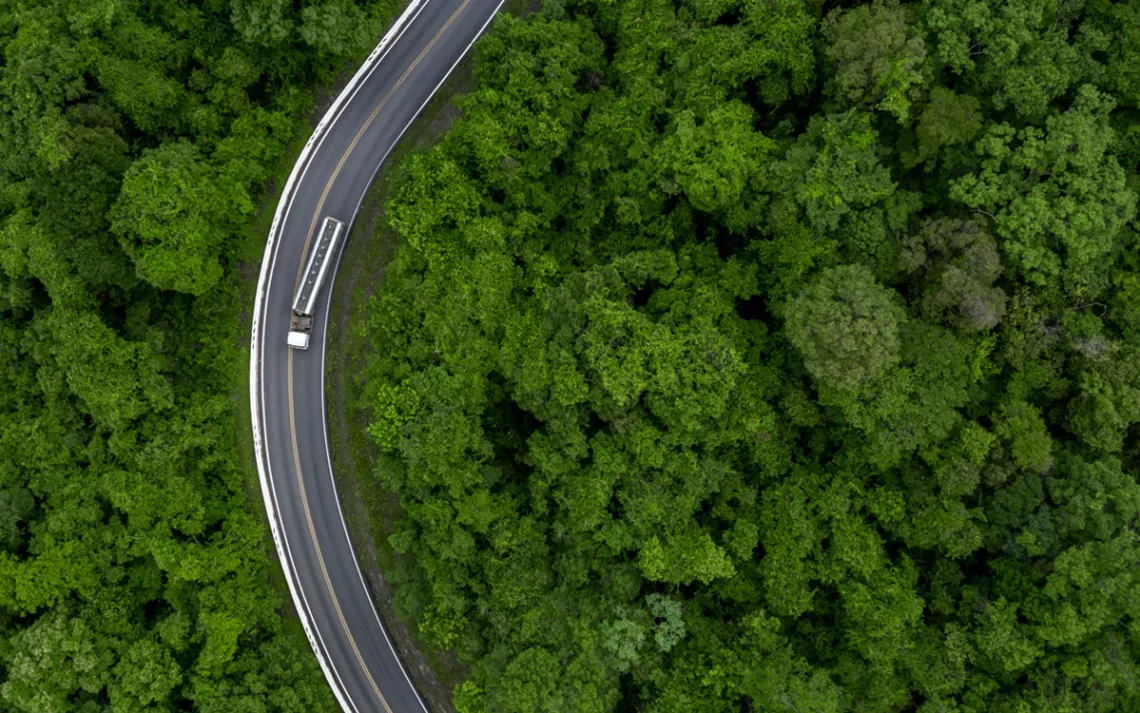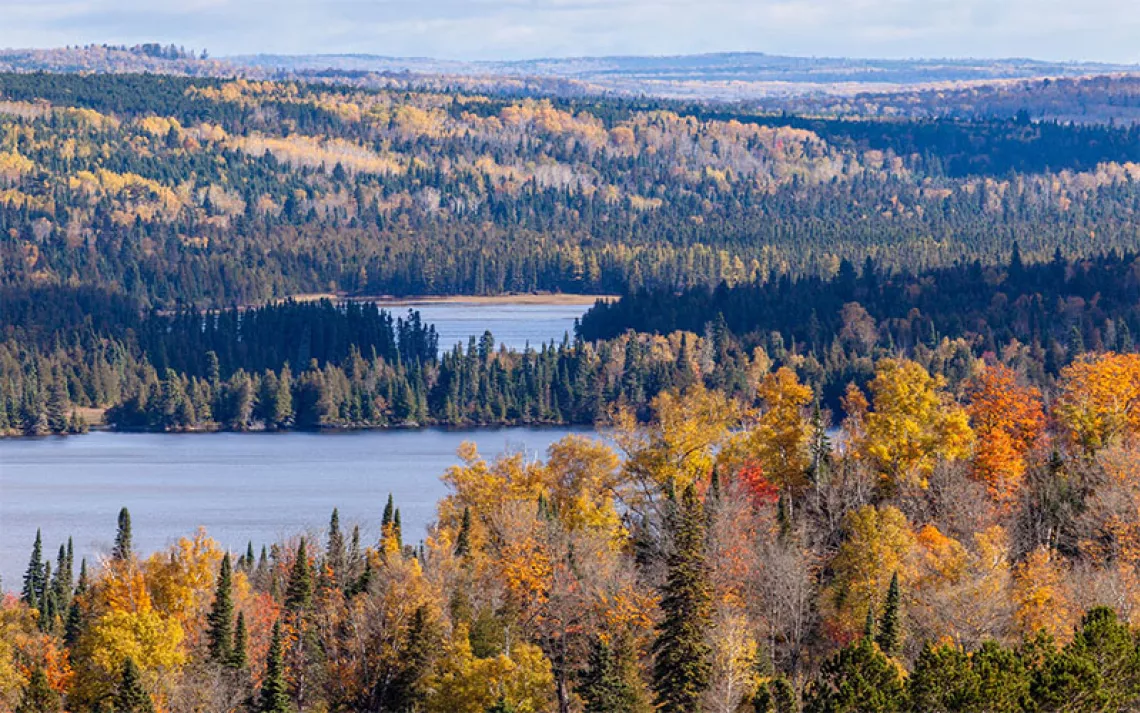Is a Big Patch of Protected Land Better Than Many Small Patches?
Landscape experts have been entrenched in this debate for decades. Now some of them are joining forces to find an answer.

Photo by AvigatorPhotographer/iStock
Imagine two lush forest areas of equal size—one is a single large area, and the other is chopped into two separate sections, split by agricultural land. If there was only enough funding to protect just one of these two types of landscapes, which patch would you bet on?
This isn’t a riddle but a resource allocation question conservation advocates and leaders face on a daily basis. President Biden’s advisory board deals with it when looking at the roll-out of the plan to protect 30 percent of US lands by 2030. Nonprofits must wrestle with it when thinking about their missions for programs like the Yellowstone to Yukon Initiative. And state leaders consider it for policies, such as the Northwest Forest Plan.
Yes, habitat loss and degradation due to deforestation, mining, water extraction, urban development, and industrial activities are the main drivers of extinction and the biodiversity crisis, and all ecologists agree that the more land conserved, the better. But if there is no land loss and there is just fragmentation—the same area of land divided into several disparate patches—many species continue to thrive, albeit counterintuitively.
It’s a question of pattern, and it’s one that conservation researchers have been butting heads over for decades. The disagreement started in the 1970s as the Single Large or Several Small—SLOSS—debate and is still one of the ripest controversies in conservation now. According to some scholars, squashing the dispute might require upending much of how we think about biodiversity and conservation overall.
“We're fighting each other instead of fighting the real demon here, which is land cover and land use change, which is impacting biodiversity,” said Jonathon Valente, an ecologist at Auburn University in Alabama.
Large patches of protected land are imperative for the well-being of animals like mountain lions, who need a lot of land to roam, or spotted owls, who prefer the hidden interiors of forests rather than the edges. In general, people in the conservation field believe that the larger the habitat, the richer the biodiversity. It’s what ecology experts call the “species–area relationship.” When researchers deliberately fragmented some intact tropical Amazon forests near Manaus, Brazil, in 1979 as part of the Biological Dynamics Forest Fragments Project, their results were mainly negative. For instance, many bird species—especially ones munching on insects—simply disappeared, and it took decades for them to make a comeback, as suggested in a 2020 paper.
“I have done a variety of research that suggests quite clearly that less fragmented ecosystems are better for populations and communities than more fragmented ecosystems,” said Robert Fletcher, an ecologist at the University of Florida, who’s dedicated much of his research to this qualm, even outside the lab.
Crucially, having a bunch of split-up patches isn’t ideal because human-caused habitat fragmentation invites more human interference, according to Fletcher. Roads, even dirt ones, bring people, which creates business, spurs commerce, furthers development, and leads to even more habitat loss. “There's lots of collateral effects that arise,” Fletcher said. Fragmented systems often have a greater intensity of land use surrounding the untouched land, he says, and when it’s roads that fragment habitats, the road then provides easier access into those separated plots of land, likely allowing for more illegal hunting and poaching.
In a 2020 paper, scientists poring over data for 2,230 species in the Atlantic Forest of Brazil found that “dismissing habitat fragmentation as a powerful force driving species extinction in tropical forest landscapes is premature and unsafe.” Similarly, a review published in Science analyzing a total of 76 studies concluded that habitat fragmentation shrinks biodiversity by 13 to 75 percent.
Yet when Lenore Fahrig, an ecologist at Carleton University in Canada, first created a computer simulation testing out the changes in biodiversity—everything from the total size of populations to their rate of reproduction, mortality, movement distance, and more—in virtual landscapes that became scattered and split up, she couldn’t find any of the big negative impacts of fragmentation alone that she had set out to look for.
“At the time, I just assumed that fragmentation is bad,” said Fahrig. “I spent, like, six months running simulations, and I couldn't find a situation where fragmentation did matter. That was my sort of eureka moment where I thought, wow, OK.”
This lightbulb instant was in 1992, and since then, Fahrig has continued to lead everything from computer simulations to field tests to reviews of other scholars’ work, all suggesting that biodiversity can still thrive even though a landscape might be fragmented, as long as there is enough of the habitat in the landscape. This has created a whole new school of thought.
Fahrig’s 2017 review of 118 studies by other researchers looking into additional habitats such as seagrasses, coral reefs, and grasslands corroborates her lab’s work. The results indicate that about 70 percent of the time, fragmentation does not affect the abundance of individual animals, and when it has an effect, about 65 percent of the effects increase the abundance of individuals, Fahrig said. And when looking at the number of species, the effect of fragmentation is almost always positive. (An exception seems to be for amphibians and reptiles, where there is a positive fragmentation effect on the number of species only 40 percent of the time.)
The reasons this data shows positive effects could be manifold and probably true in some situations but not others. For one, the more scattered the pieces of untouched land, the more likely they are to represent a wider variety of microhabitats—it’s more likely for there to be more range in soil type, or more variation in vegetation, or a little bit of alternative in temperatures too. This works well for critters like leopard frogs, for example, which need both wetland habitat and meadow habitat, said Fahrig. Smaller patches also mean more edge-inclined species benefit from hanging out on the outskirts of forests. This is especially true for birds like the golden-winged warbler or the eastern towhee. In a 2018 study, researchers found that fragmentation was a boon for the indigo bunting, a forest-edge-loving bird that benefited from the extra habitat created.
Other reasons fragmentation yields positive data might be that migrating species can stop and refuel while moving throughout the landscape, and they can more easily recolonize a segment of land where their species might have been extirpated. Predators and prey can engage in longer games of hide-and-seek—stabilizing populations—because they can temporarily find refuge in separate land patches. Scattered, discontinuous portions of protected land could also serve to stop calamities, like fire or disease, from spreading unchecked, snowballing, and quickly wiping out entire populations.
“We have to talk separately about the effects of the loss of habitat and fragmentation, because it really actually matters a lot,” said Fahrig, as studies that come up with results on fragmentation being harmful to biodiversity often conflate the two. For example, if there are more roads in landscapes with many small patches than in landscapes with few large patches, the negative effect is due to road kill, not habitat fragmentation itself. This study suggested that a fragmented landscape is detrimental to species diversity, but when her team analyzed the exact same data, it showed that a group of small patches had more species than a group of large patches when the total amount of habitat was the same.
“The value of small patches, the cumulative value of small patches, when you add them up together, they are at least as valuable, if not more so, than that same area in a couple of large patches,” Fahrig said, making efforts to save small bits of habitat just as crucial—and there shouldn’t be thresholds for the minimum amount of land that needs to be conserved.
But it seems that neither of these schools of thought fit all situations—which is why entire teams of scientists come to what look like mutually exclusive, opposite conclusions to an age-old question over and over again. Crucially, conservationists working on the ground and in the field think it’s time to move on.
“These concepts and these principles, which I still think matter, just don't tend to enter the equation as much for those of us now working more in the trenches of conservation,” said Brett Dickson, a landscape and wildlife ecologist who is now chief scientist at Conservation Science Partners. In the real world, there’s little time and opportunity to apply this debate without several other factors weighing in, mostly political ones, so all fragmentation is bad, and it’s just a matter of quantifying how bad it is for any given scenario.
According to Dickson, creating networks of protected areas, focusing on their location, and fleshing out the connective tissue between protected patches—whether large or small—is what matters moving forward.
In light of the field’s general frustration, Valente from Auburn University recently penned a paper together with Fletcher and Fahrig to find solutions for the future of the debate. The team is working to develop a unified measure for running these kinds of experiments so that both sides of the debate use the same tools and values. As of now, there are too many methodological differences between how different teams run their fragmentation studies, so it’s like comparing apples and oranges, Valente said. There are different ways of measuring fragmentation, what we mean by "good" or "bad" for biodiversity, and even what we mean by biodiversity—be it species richness, abundance of individual species, or exactly which species are being protected.
“I do think that ‘good and bad’ is too simple, and I think ‘it depends’ is too vague,” Valente said. What do we most want to conserve? Is it that we want to conserve a certain amount of natural area? Is it that we're trying to target a certain number of species? Is it that we don't want species to suffer extinction? Those aspects are intimately related, but they lead to slightly different strategies and focuses. Bridging the gap from the ivory towers of academia to the real-life conservation examples out in the world is imperative—and this will look different for different case scenarios.
 The Magazine of The Sierra Club
The Magazine of The Sierra Club






